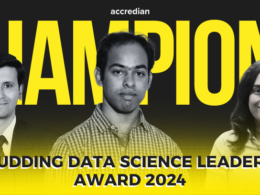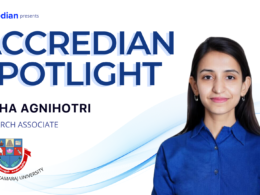Meet Shivani Manav, a determined data enthusiast from the November ’21 Cohort of Accredian’s GCD program. With a previous background in a hybrid role for a government organization, Shivani spent a majority of her time conducting analytical reporting and gaining insights.
Seeking to enhance her work experience and explore the world of data science, Shivani enrolled in Accredian’s GCD program.
Now, armed with a new skill set, Shivani is determined to secure a Core Data Analyst profile and excel in her career.
Let’s dive into Shivani’s journey and discover how Accredian helped her achieve her goals.
Question 1: Which program and batch are you part of at Accredian and tell us more about your current work profile.
Shivani: I am from the November ’21 Cohort, and I enrolled in Accredian’s GCD program to enhance my work experience. Previously, I worked in a hybrid role for a government organization, where a majority of my tasks involved analytical reporting and gaining insights.
Currently, I am seeking a Core Data Analyst profile.
Question 2: Walk us through your career journey & what got you interested in Data Science & Machine Learning.
Shivani: I began working in a Web services company in 2015 as a Chat Support Executive for a YouTube-based process. As a team member, I contributed to lead generation and interacted with content creators. Providing satisfactory responses was imperative to succeed in this business.
Later, I worked with ICICI Merchant Services that dealt in the sales of POS terminals to merchants. I had a similar work profile, with the additional role of processing data in Excel workbooks and documenting cases in the CRM.
When the contract term was about to end, I received an offer from Concentrix for the position of Senior Operations Representative. I joined Concentrix and attended process-related training, but the nature of repetitive tasks involved did not let me engage for long. I left after just three months and joined a government organization that provides IT solutions to various government sectors.
I started working there as a Business Analyst, and gradually took on more responsibilities related to data. During this phase, I heard a lot about ML, AI, and Big Data and started attending meetups. One such conference was Women in AI, where speakers from companies like IBM introduced us to ML and AI domains and how they were making an impact in various industries.
It was there that I first heard of augmented reality and virtual reality terms, which are the origins of the Metaverse. I was fascinated by the fact that what we could only watch in sci-fi movies was becoming a reality. This event was wondrous, and it induced me to upskill when the world is changing around us.
My actual journey began when I joined the Accredian GCD program in 2021. Since my role was associated closely with data, I decided to pursue a career in the data science field.
Question 3: What all tools and packages in Data Science & Machine Learning have you mastered in your Data Science & AI program at Accredian so far?
Shivani: First and foremost is NumPy, which is a fundamental package for scientific computing in Python. Second is Pandas, an acronym for “Python Data Analysis”, which is a package used for the manipulation and analysis of series and tabular data. Third are visualization libraries like Seaborn and Matplotlib.
These are the libraries used for creating attractive and animated graphics, and visualizations, and the Python folium library is used to visualize manipulated data in Python on an interactive Leaflet map.
I was introduced to this package while working on the EDA Capstone Project. Scikit-learn is the most useful library for machine learning in Python. The tools that are used while working with these Python packages are Jupyter Notebook and Google Colab for visualizations. In addition to Python packages, I also gained exposure to Tableau.
Question 4: What are some of initial challenges when you got started on your Data Science journey and how did you overcome it?
Shivani: The initial challenge was to get a hold of the Python syntax and write code to solve a problem. The answer to this is practice, practice, and more practice. Consistency is really important, and this has started to give me the confidence to achieve my goals.
Question 5: What is the goal of Data Science?
Shivani: The objective of Data Science is to explore and gain insights from structured and unstructured data using approaches such as statistical analysis or machine learning. These insights can be leveraged to make informed decisions and optimize business processes.
Question 6: In your view, how has Data Science evolved in last few years?
Shivani: The evolution in the Data Science field can be associated with gradual technological advancements in big data cloud computing, AI, and ML, along with the GDPR policies in chronological order, starting from the year 2011. Apache released Hadoop version one after beating supercomputers and Google’s MapReduce implementation.
Data science is concerned with really big data that traditional computing resources could not accommodate. Therefore, due to advancements in cloud technology, organizations’ approach to storing, securing, and processing data has also evolved.
In nearly all organizations, cloud-based platforms are being used, and we are also seeing cloud-based applications becoming a part of our lives. Realizing the importance of data, organizations’ interest in finding patterns and making better business decisions has been paramount in the current scenario.
Speaking about recent advancements in AI, it can be seen in the year 2014 when Alexa was born. In 2015, Jack Clark of Bloomberg wrote that it had been a landmark year for Google, as machine learning, deep learning, and artificial intelligence officially entered the realm of data science.
Google DeepMind AlphaGo defeated a Korean Go champion who won 27 major tournaments from 2000 to 2002 to 2016. In 2016, IBM Watson Data Analysis processor, an AI technology in medicine, detected leukemia in a woman that was previously missed.
In August 2017, an Open AI machine learning bot played at the International 2017 Dota two tournament. In 2018, Google Duplex, a service to allow an AI assistant to book appointments over the phone, was introduced. Microsoft introduced its natural language generation in 2019, which was then the largest language model ever published at 17 billion parameters.
In 2020, GPT-3, a state-of-the-art auto-regressive language model, was built. It is well-known to produce a variety of computer codes, poetry, and other language tasks. These technologies have driven innovations over the past decade from personalized shopping and entertainment to virtual world metaphors and self-driven vehicles.
Question 7: What are the current trends in Data Science that you are most excited about?
Shivani: The current trends in data science that I am interested in are augmented consumer interfaces, autoML, ML Ops, and ethical and responsible AI.
We hope you enjoyed reading this interview. Check out the Accredian Spotlight for more interesting student stories like this.





